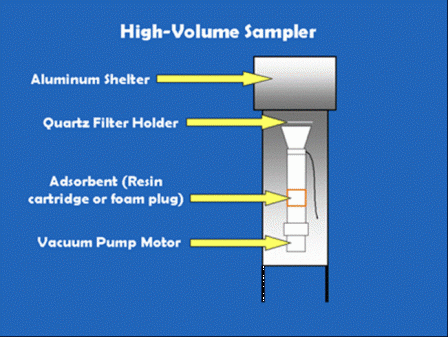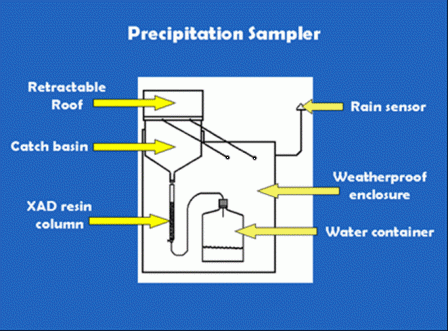Great Lakes Integrated Atmospheric Deposition Network - Sampling Methods
Air samples are collected for 24 hours every 12 days using a high-volume air sampler. The high-volume sampler captures particles in the air by using a vacuum pump to pull air through a filter. The particles then pass through a resin cartridge called an adsorbent to capture gases.
High Volume Sampler

Every month a mechanical precipitation![]() precipitationWater falling to the Earth. Mist, sleet, rain, hail, fog and snow (wet deposition) are the most common kinds of precipitation. sampler collects rain and snow precipitation samples. When rain or snow falls, a sensor
precipitationWater falling to the Earth. Mist, sleet, rain, hail, fog and snow (wet deposition) are the most common kinds of precipitation. sampler collects rain and snow precipitation samples. When rain or snow falls, a sensor![]() sensorAn instrument that measure (senses) a physical condition or variable of interest. Floats and thermocouples are examples of sensors. detects the moisture and the retractable roof of the precipitation sampler opens, exposing a funnel-shaped catch basin. Rain and snow fall into the funnel, then through the resin column. The resin captures the pollutants. The water, with the pollutants removed, drains into a container. The volume of water measured in the container determines the amount of precipitation that fell during the one-month sampling period.
sensorAn instrument that measure (senses) a physical condition or variable of interest. Floats and thermocouples are examples of sensors. detects the moisture and the retractable roof of the precipitation sampler opens, exposing a funnel-shaped catch basin. Rain and snow fall into the funnel, then through the resin column. The resin captures the pollutants. The water, with the pollutants removed, drains into a container. The volume of water measured in the container determines the amount of precipitation that fell during the one-month sampling period.
Precipitation Sampler

Meteorlogical Data Tower
A tower at each site remotely transfers information onto a data logger which records meteorological![]() meteorologicalPertaining to the weather. measurements such as:
meteorologicalPertaining to the weather. measurements such as:
- wind speed,
- wind direction,
- air temperatures,
- barometric pressure
 barometric pressureThe total pressure exerted by the atmosphere. This term is synonymous with "atmospheric pressure.",
barometric pressureThe total pressure exerted by the atmosphere. This term is synonymous with "atmospheric pressure.", - relative humidity, and
- solar radiation
 solar radiationRadiation emitted by the Sun. It is also referred to as short-wave radiation. Solar radiation has a distinctive range of wavelengths (spectrum) determined by the temperature of the Sun. See ultraviolet radiation, infrared radiation, radiation..
solar radiationRadiation emitted by the Sun. It is also referred to as short-wave radiation. Solar radiation has a distinctive range of wavelengths (spectrum) determined by the temperature of the Sun. See ultraviolet radiation, infrared radiation, radiation..
The data is then analyzed to determine the quantity and pollutant type.
